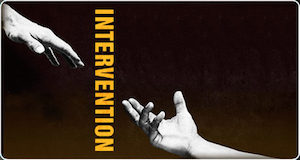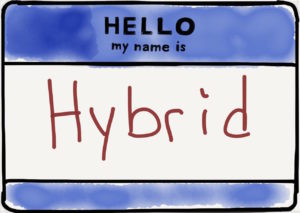Embracing the Hybrid
Intervention
Ten years ago(ish) I found myself on the wrong end of an intervention. A group of developers I had a lot of respect for cornered me in one of those fishbowl offices at a client site. You know the ones – glass on all sides… They sat me down in a small chair and stood around me. It was weird.
 “Listen dude, we need to have a talk. This waterfall crap… it has to stop. We’ve proven that it doesn’t work” (Note – these guys always seemed to use “We” as a kind of vague reference meaning “everyone in the entire universe… except you”.
“Listen dude, we need to have a talk. This waterfall crap… it has to stop. We’ve proven that it doesn’t work” (Note – these guys always seemed to use “We” as a kind of vague reference meaning “everyone in the entire universe… except you”.
They went on “You need to lean about Agile.” (Yeah, this did actually happen.)
The backstory is, we were all on a team together, all working on a project. In retrospect, what I think they meant was “We want to do Agile.” But whatever… I had respect for these guys, had enough awareness to know Agile was creeping in around the edges and that despite my previous traumatic experiences, it was something I was not going to be able to avoid forever. And so, I began my journey to the Wudang Mountains to learn the Way of the Agile.
The Quick and the Dead
Back then; there were basically two kinds of people… the Agile, and the non-Agile. If that doesn’t make sense, you can think of them as the enlightened mindful beings who have stepped out of Plato’s cave and the poor bastards who are too addicted to their pain to leave the misery of darkness.
For many years the fight for Agile was all about transformation. And by transformation, we meant that you recognized the one true god of Agile, embraced the manifesto and started shaking your head at those silly little rabbits who just hadn’t found THE WAY yet.
As a PM, it was a weird time. After having spent the better part of 10 years trying to master traditional PM techniques, I was suddenly in a world where not only did I not understand how things worked, but where I was walking around with the scarlet letters PMP on my chest. I hid those letters from the Agile people as best I could, convinced that at any moment I’d be discovered and out-ed as PMP who had infiltrated the Agile party.
Showing Transformation the Door
 Over the past two years, something has begun to shift – both in and outside of Agile. Things are a bit less polarized. I run into less PMPs trying to convince me that waterfall is “just really fast Agile”, less Agile people who want to ship the waterfall off to leper colony that will (obviously) never actually deliver, and less of those intimidating Lean guys who look down upon the Scrum people like they rode to school on the “special bus”. Even the word “transformation” seems to have been discovered by the bouncers. They’ve been polite about it, but clearly that word has been asked it to finish its drink and move towards the door. The word “transformation” IMHO, scares people a bit because for a while there was this perception that you’d become Agile… like it was this thing that would happen to you… and then Pinocchio would become a real boy.
Over the past two years, something has begun to shift – both in and outside of Agile. Things are a bit less polarized. I run into less PMPs trying to convince me that waterfall is “just really fast Agile”, less Agile people who want to ship the waterfall off to leper colony that will (obviously) never actually deliver, and less of those intimidating Lean guys who look down upon the Scrum people like they rode to school on the “special bus”. Even the word “transformation” seems to have been discovered by the bouncers. They’ve been polite about it, but clearly that word has been asked it to finish its drink and move towards the door. The word “transformation” IMHO, scares people a bit because for a while there was this perception that you’d become Agile… like it was this thing that would happen to you… and then Pinocchio would become a real boy.
For better or worse, people seem to have discovered it doesn’t always work like that. When an organization adopts Agile, it’s sort of like when someone decides to get in shape. You may put in a lot of time and effort and reach the stage where you can acknowledge that your goals have been achieved and you are “in shape” (or “Agile”). But, the only way to maintain this is to keep pushing harder and harder each day, and there is no real end point. Becoming Agile is not something you finish… It is a continual journey.
If you’ve ever spent any amount of time in a gym, you know there are always going to be model examples of physical magic with 7% body fat. They are there at all hours of the day or night. Sometimes it seems like they exist for the sole purpose of crushing your self-esteem and making you feel like you MUST WORK HARDER. We have equivalents to that in Agile too.
The Digital PM Revolution
On the other side of the hall is a completely different party. These are the Digital PMs. They are younger, possibly a little more open-minded than the Waterfall or Agile people. They consume new tools and practices like they were shot gunning beers. The pace at which they adopt and shift <cough>”pivot”</cough> can make even the Agile folks a little dizzy. What’s worse (or better) is that they never sit around debating whether something is Agile or not. They really don’t seem to care. They just want stuff that works and they are totally happy mixing up their process Garanimals to get to something that helps them survive the day and serve the client.
It has been awhile since I’ve been asked to join a waterfall vs. Agile debate. It’s been awhile since anyone really seemed to care much about that (because now they are more focused on “outcomes”). But, in the same way that each of us reaches a point in our gym rat phase where we think, “where I am now is good enough, I’d like to just maintain this”, and the DPMs have found a way to live in a world that straddles the line between Agile and waterfall. Perhaps the hybrid model is going to emerge as a viable alternative that can stop being a milestone and become an actual destination.
“Scrum, but” has been around for a long time, always discussed with shame – like it was a stage people were trying to get through. Now that we’ve reached a point where the organizations who were going to have an easy time making the switch have done so, we’re focused on the ones who have a harder time with the change. For some of the larger organizations it can be tough for them to just turn on a dime and get their Agile on.
 Hello, My Name Is Hybrid
Hello, My Name Is Hybrid
My personal theory is that once we reach a point where we acknowledge/decide that the hybrid is going to be here and that this is an okay thing, that we’re going to see a major shift in the focus of thought leaders. You can see evidence of this already as they start to try to come up with tools/practices to let them measure waterfall and Agile projects in the same portfolio. What I think we are going to see emerge is patterns of practices and formulas for difference orgs to try out and adapt to get to better, quicker delivery (outcomes). When this happens, and begins to spread, Agile will stop being something we do, and become something we are.
And maybe (hopefully) no one will care about Agile, waterfall or hybrid at all – as long as we’re delivering.
